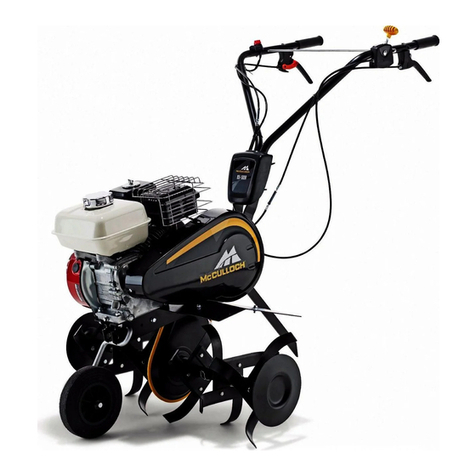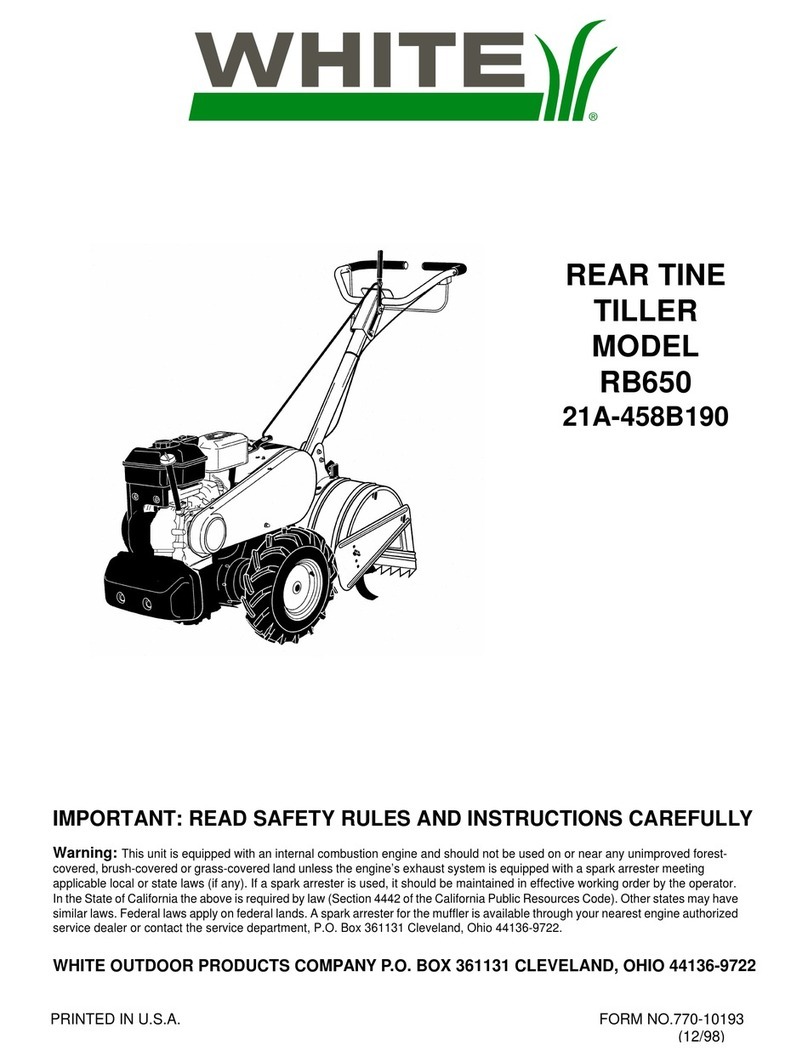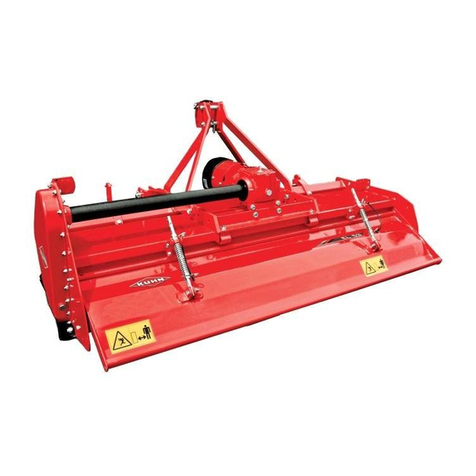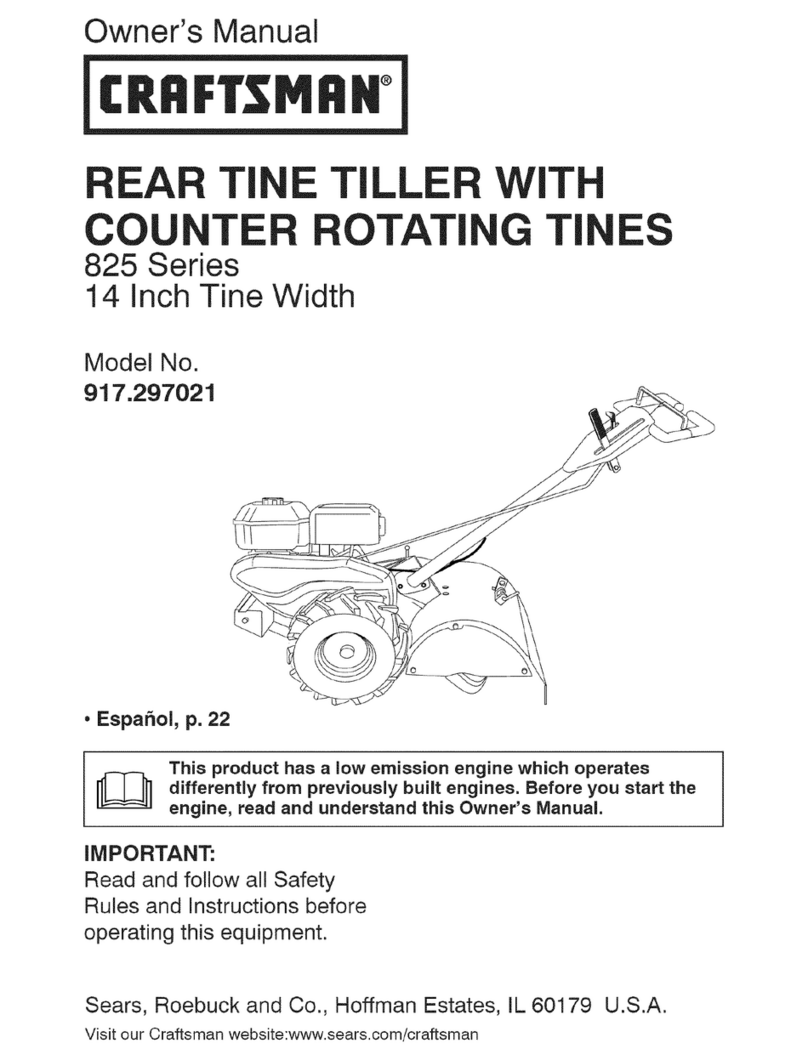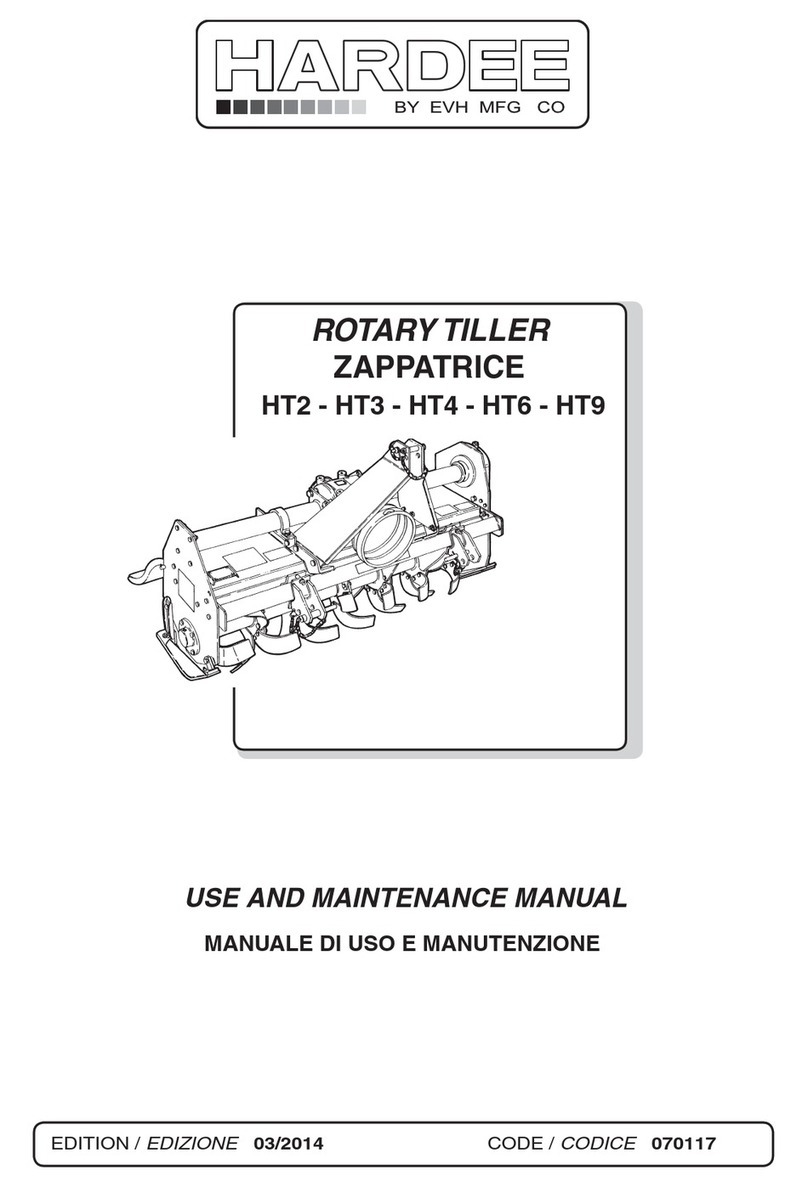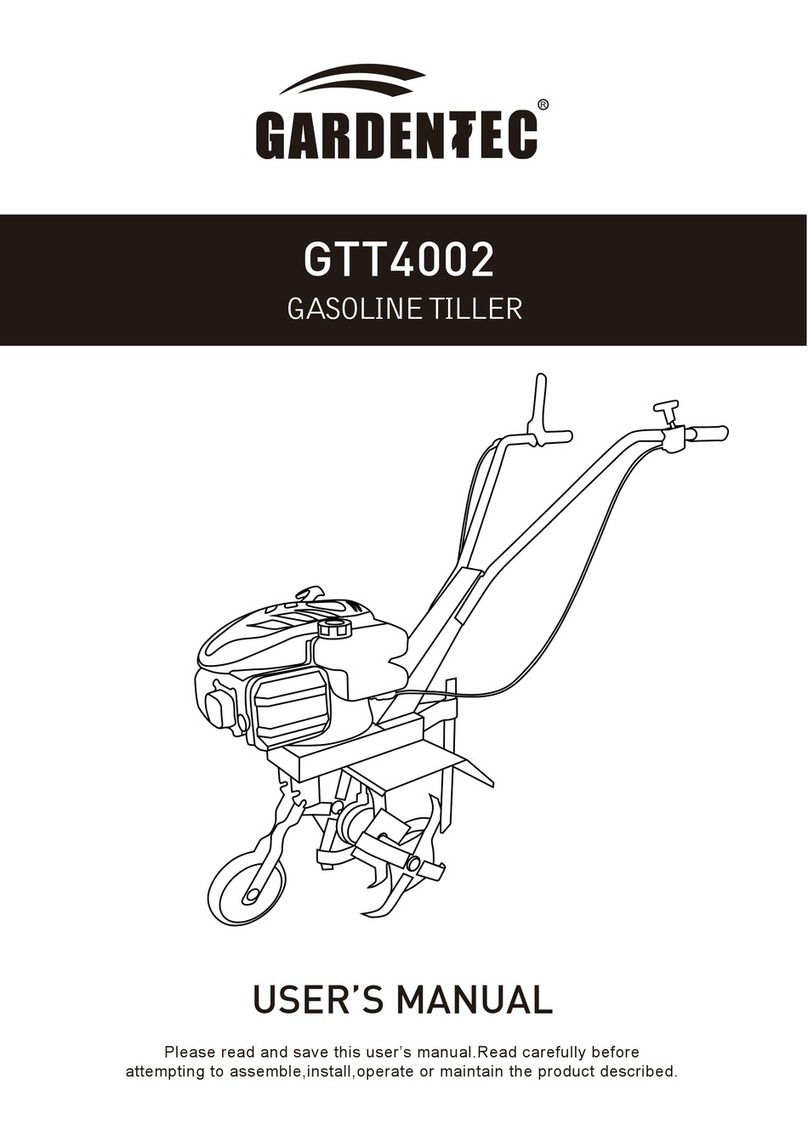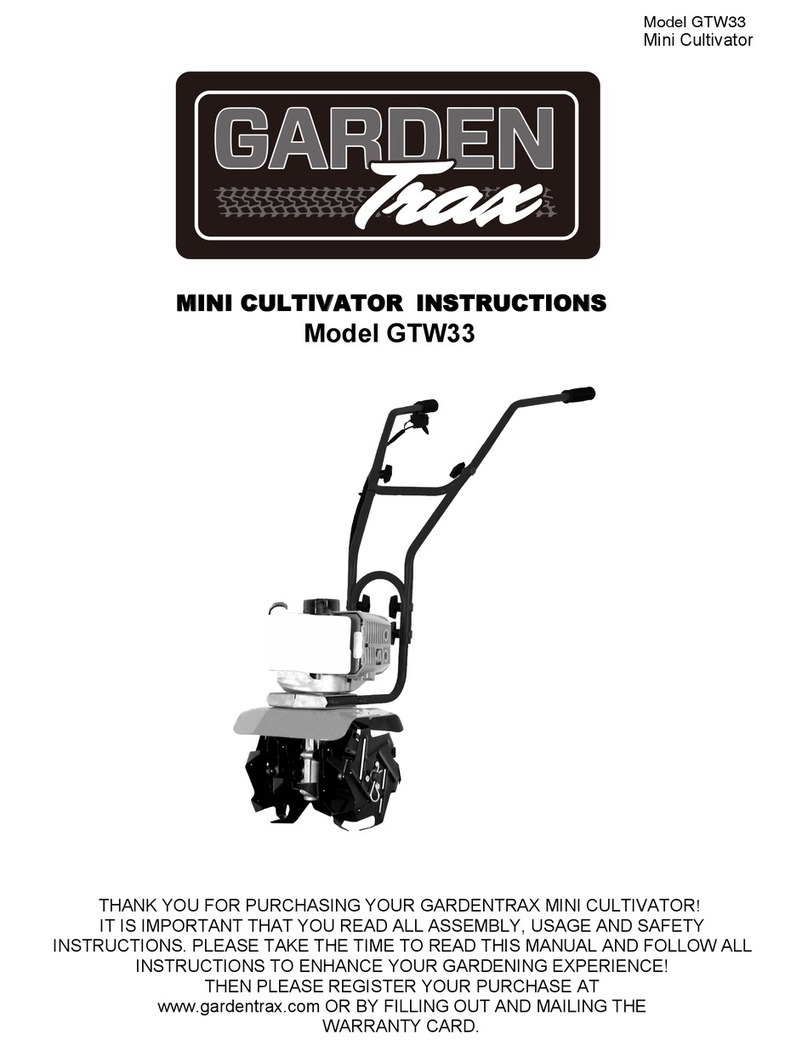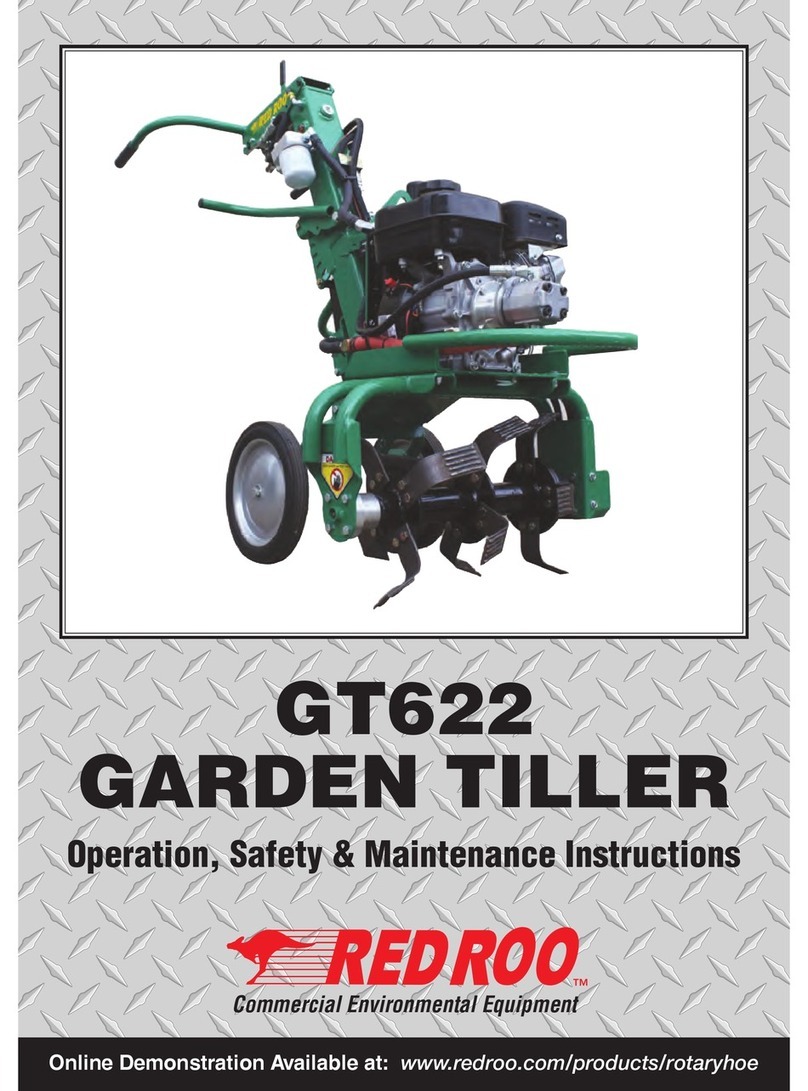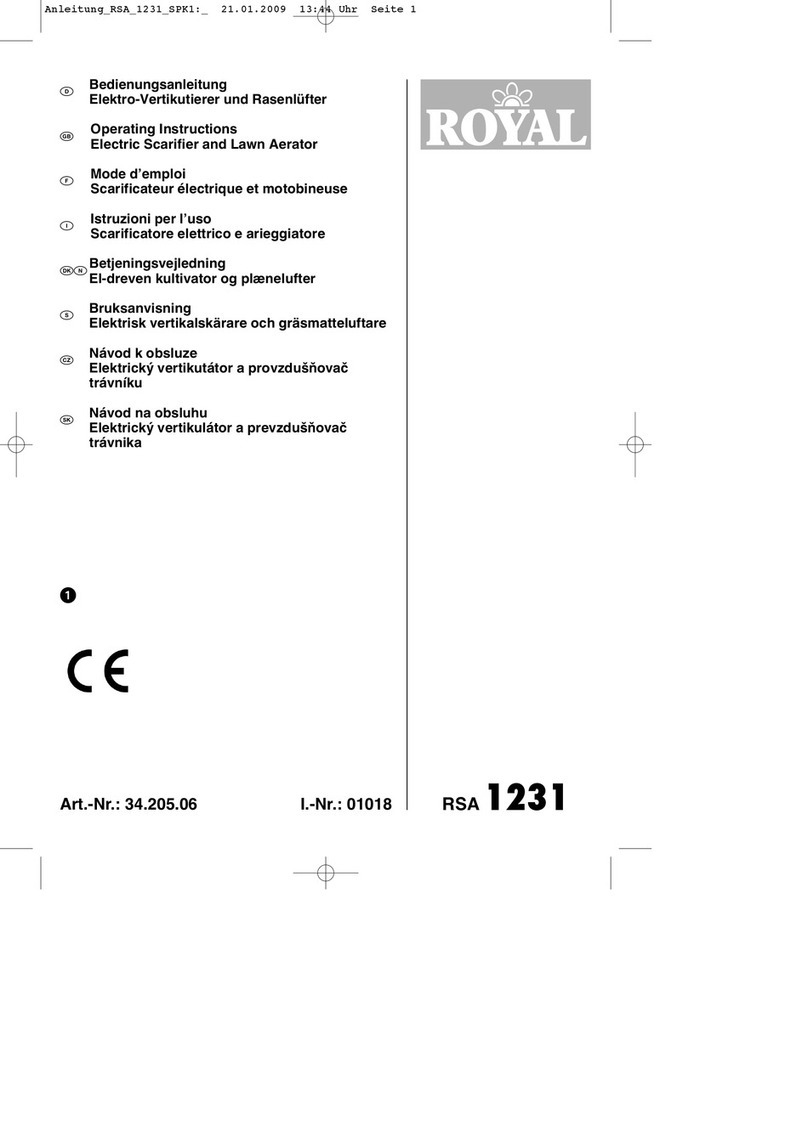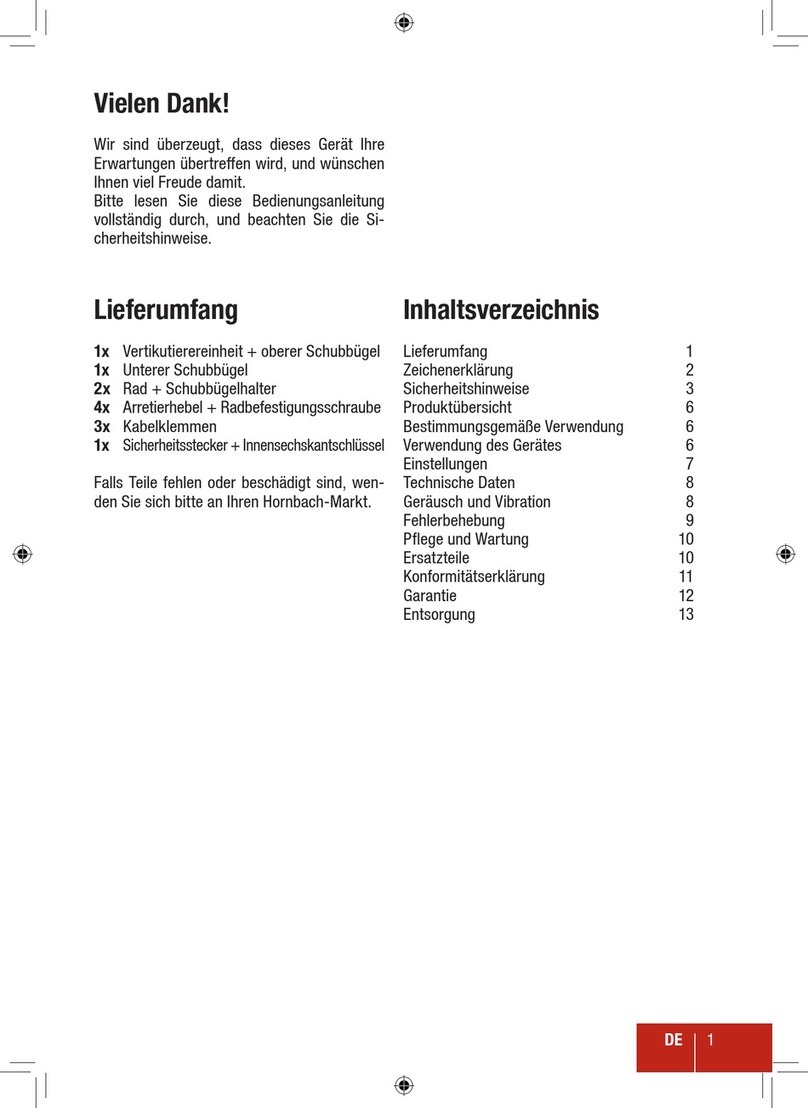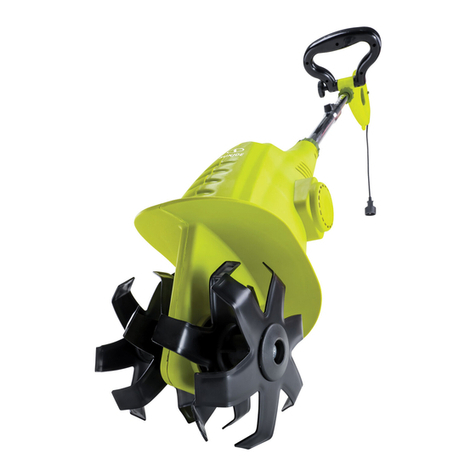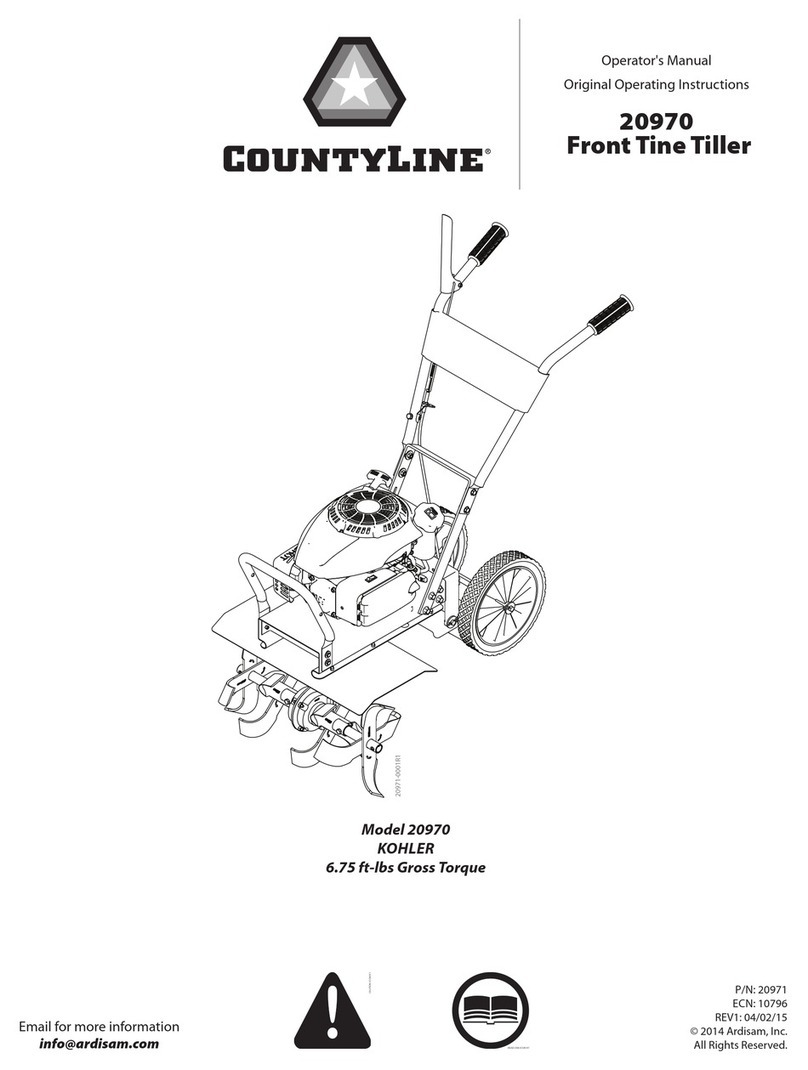Avantco A442314 User manual

Spring tine cultivator
2021 1
Operator's Manual for Attachment
Spring tine cultivator
Product number
A442314
English
A449586 2021 1 EN 2020-
www.avanttecno.com

Spring tine cultivator 2021 1

Spring tine cultivator 2021 1
CONTENTS
1. FOREWORD ............................................................................................................................................4
Warning symbols used in this manual ............................................................................................................................... 5
2. DESIGNED PURPOSE OF USE.............................................................................................................6
3. SAFETY INSTRUCTIONS FOR USING THE ATTACHMENT........................................................7
3.1 Personal protective equipment........................................................................................................................... 8
3.2 Safe shutdown procedure.................................................................................................................................... 8
4. TECHNICAL SPECIFICATIONS ..........................................................................................................9
4.1 Safety labels and main components of the attachment.................................................................................. 9
5. INSTRUCTIONS FOR USE....................................................................................................................11
5.1 Checks before use................................................................................................................................................. 11
5.2 Operator qualification .......................................................................................................................................... 11
5.3 Use............................................................................................................................................................................ 12
5.4 Transport position ................................................................................................................................................ 14
5.4.1 Support wheels (optional extra) ................................................................................................................ 14
5.4.2 Hydraulic support wheels (optional extra).............................................................................................. 15
5.5 Lifting accessory (Optional extra)...................................................................................................................... 16
5.5.1 Transport with lifting accessory................................................................................................................. 16
5.6 Side wheel and scraper blade (optional extra)................................................................................................ 17
5.6.1 Adjustment ..................................................................................................................................................... 17
5.7 Storage..................................................................................................................................................................... 17
6. MAINTENANCE AND SERVICE ..........................................................................................................18
6.1 Inspection of hydraulic components.................................................................................................................. 18
6.2 Cleaning the attachment ...................................................................................................................................... 19
6.3 Inspection of metal structures............................................................................................................................ 19
6.3.1 Tine maintenance .......................................................................................................................................... 19
6.4 End of life disposal................................................................................................................................................. 19
7. WARRANTY TERMS..............................................................................................................................20

4 (22)
1. Foreword
Avant Tecno Oy would like to thank you for your purchase of this attachment for your Avant loader. It has
been designed and manufactured based on years of experience on product development and manufacturing.
By familiarizing yourself with this manual and following the instructions, you ascertain your safety and ensure
the reliable operation and long service life of the equipment. Read the instructions carefully before starting to
use the equipment or performing maintenance.
The purpose of this manual is to help you to:
operate the equipment in a safe and efficient manner
observe and prevent any hazardous situations
keep the equipment intact and ensure a long service life
With these instructions, even an inexperienced user can use the attachment and loader safely. The manual
includes important instructions for experienced AVANT operators as well. Ensure that all persons using the
loader have received proper guidance and familiarised themselves with the manual of the loader, each
attachment that are used, and all safety instructions before using the equipment. Using the equipment for
other purposes or use in any other way than described in this manual is prohibited. Keep this manual at hand
throughout the service life of the equipment. If you sell or transfer the equipment, be sure to hand over this
manual to the new owner. If the manual is lost or damaged, you can request a new one from your Avant
dealer or from the manufacturer.
In addition to the safety instructions included in this manual, you must observe all occupational safety
regulations, local laws, and other regulations concerning the use of the equipment. Particularly the regulations
concerning the use of the equipment on public road areas must be observed. Contact your Avant dealer for
more information about local requirements before you operate the loader on road areas.
Contact your local AVANT dealer for any questions, service, spare parts or about any problems that may
occur with the operation of your machine.
This manual contains the original instructions in English. Due to continuous product development some of the
details shown in this manual may differ from your equipment. Pictures may also depict optional equipment or
features that are not currently available. We reserve the right to change the contents of the manual without
notification. Copyright © 2021 Avant Tecno Oy. All rights reserved.

5 (22)
.
Warning symbols used in this manual
The following warning symbols are used throughout this manual. They indicate factors that must be taken into
account to reduce the risk of personal injury or damage to property:
WARNING SAFETY ALERT SYMBOL
This symbol means: “Warning, be alert! Your safety is involved!”
Carefully read the message that follows, it warns of an immediate hazard
that could cause serious personal injury.
The safety alert symbol by itself and with related safety statement
indicates important safety messages throughout this Manual. It is used to
draw attention to instructions involving your personal safety or the safety
of others. When you see this symbol, be alert, your safety is involved,
carefully read the message that follows, and inform other operators.
DANGER
This signal word indicates a hazardous situation which, if not avoided, will cause
death or serious injury.
WARNING
This signal word indicates a potentially hazardous situation which, if not avoided,
could cause serious injury or death.
CAUTION
This signal word is used when minor injury could result if the instructions are not
followed properly.
This signal word indicates information about the correct operation and maintenance
of the equipment.
Failure to observe the instructions accompanying the symbol can lead to equipment
breakdown or other property damage.

6 (22)
2. Designed purpose of use
The Avant Spring tine cultivator is a towable attachment that is intended for levelling and loosening the
surfaces of horse arenas, and for cultivating smaller fields and similar surfaces. This attachment is compatible
with Avant compact loaders that are shown in Table 1. To operate the attachment, the loader must be
equipped with a rear tow hitch ball. Hydraulic rear outlet is required only, if the attachment is equipped with the
optional hydraulically adjustable wheels (A37547).
With the optional lifting kit A449060 it is possible to mount the cultivator to the quick coupling plate of the
loader boom. The lifting kit also makes it possible to add additional weights on the attachment for areas where
extra weight is needed for better performance of the attachment.
There are 15 spring loaded S shaped tines with replaceable teeth in two rows which cultivate the soil up to
100 mm depth. Working depth can be adjusted by adjusting the height of the rear field roller. The spring tines
penetrate quite deep in the ground during operation and the field roller compacts the ground, leaving a great
looking finish to the surface. Therefore the attachment is suited for arenas with gravel or sand sub-base,
where there is no geotextile fabric, rubber, or other materials which the tines could dig up.
When there is a need to transport the attachment outside horse arenas, the optional support wheel kit
(A36593) should be installed and the wheels must be lowered to protect the attachment from damage while
driving on hard surfaces. The extra wheels are also available as hydraulically adjustable (A37547), in which
case the loader must be equipped with a double acting rear hydraulics outlet.
Other options that are available include the side wheel kit A418962, and side scraper blade A36471 for
working at areas with side walls.
The Spring tine cultivator is not designed for any other use than what is specified in this manual and must not
be used for any other purposes than what is intended for.
The attachment has been designed to require as little maintenance as possible. The operator can perform
regular maintenance tasks. All repair work can’t be performed by the operator, and demanding repair and
maintenance operations are to be left for professional technicians. All maintenance work must be done using
proper safety equipment. Spare parts must be identical with original specifications, which can be ensured by
using only original spare parts. A separate spare parts catalogue may be available, consult your Avant dealer.
Familiarise yourself with the manual's instructions regarding service and maintenance. Please contact your
AVANT dealer if you have additional questions about the operation or maintenance of the equipment, or if you
require spare parts or maintenance services.
Table 1 - Spring tine cultivator - Compatibility with Avant loaders
Model
220
225
225LPG
313S
320S
420
423
520
523
R20
525LPG
R28
528
530
630
R35
635
640
735
745
750
755i
760i
850
860i
e5
e6
A442314 •- ••••••
The Spring tine cultivator can be used with all articulated frame Avant loaders that are equipped with 50 mm
ball trailer coupling.

7 (22)
3. Safety instructions for using the attachment
Please bear in mind that safety is the result of several factors. The loader-attachment combination is highly
powerful and improper or careless use or maintenance may cause serious personal injury or property
damage. Due to this, all operators must carefully familiarise themselves about correct use and the operator's
manuals of both the loader and the attachment before starting operation. Do not use the attachment if you
have not completely familiarised yourself with its operation and the related hazards.
DANGER
Misuse, careless use, or using an attachment that
is in poor condition may
cause risk of serious injuries.
Familiarise yourself with the controls of the loader,
correct coupling procedure, and the correct way to operate the attachment at a safe
area. Study especially how to stop the equipment in a safe ma
nner. Read all safety
precautions carefully.
Read all safety instructions carefully before handling the attachment
WARNING
Risk of run-over by loose attachment or loss of control - Always ensure
positive locking of the trailer coupling.
Risk of suffocation - Never operate the loader indoors or at poorly ventilated
areas. Ensure that ventilation is sufficient when operating indoors. Do not operate the
loader in closed spaces regardless of the engine or fuel type. Exhaust gases may
concentrate to hazardous levels.
Never transport loads or persons with the harrow.
Make sure to use only an attachment that is in good condition. Check the attachment
thoroughly in regular intervals. Do not modify the attachment in a manner that would
affect its safety. It is p
rohibited to drill holes on the attachment, and welding or other
means of fixing hooks or other objects on the attachment is strictly prohibited.
Use the equipment only for its intended purpose. Other use may create unnecessary
safety risks, and the equipment may get damaged.
Pay attention to the surroundings and any other persons and machines moving in the
vicinity. Pay attention to the contours of the terrain and other hazards, such as
branches and trees that can reach to the driver's area, loose ro
cks, and slippery
surfaces.
Shut down the loader and place the attachment to a safe position as shown in Safe
stopping procedure before any cleaning, maintenance, or adjustments.
Make sure that the loader is equipped with necessary safety components, and that
they are in working condition. Seat belt must be used. If there are specific hazards
related to the operating area, use appropriate safety equipment.
Also read the safety instructions and correct use of the loader from the operator's
manual of the loader.
.

8 (22)
3.1 Personal protective equipment
Remember to wear proper personal protective equipment:
The noise level at the driver's seat may exceed 85 dB(A) depending on loader
model and operating cycle. Extended exposure to loud noise can cause
hearing impairment. Wear hearing protection while working with the loader.
Wear protective gloves.
Wear safety boots whenever working with the loader.
Wear safety glasses e.g. when handling hydraulic components.
. ..
3.2 Safe shutdown procedure
Safe position of the attachment, before leaving the loader or the attachment unattended
WARNING
Always set the attachment to a safe position before going near the attachment.
Safe position will prevent unintentional movements of the attachment. Safe sto
pping
procedure:
Lower the boom completely down (and lower any attachment possibly fitted on the
loader boom on the ground).
Shut down the loader engine and lock the parking brake.
Prevent moving of an uncoupled attachment. Use blocks if necessary. If the
attachment is equipped with transport wheels, lift them up so that the attachment
will not move.
Release the residual pressure from the hydraulic system; move all hydraulic control
levers to their extreme positions a couple of times.
Prevent starting of the machine, remove ignition key.
Never climb on the attachment.

9 (22)
4. Technical specifications
Table 2 – Spring tine cultivator - Specifications
Product number A442314
Working width: 1 530 mm
Other dimensions: See overview
Weight: 198 kg
Compatible AVANT loaders: See Table 1, Designed purpose of use
Options:
Transport wheel kit, manual: A36593
Transport wheel kit, hydraulic: A37547
Side wheel: A418962
Side scraper blade: A36471
Lifting accessory: A449060
4.1 Safety labels and main components of the attachment
Listed below are the labels and markings on the attachment. They must be visible and readable on the
equipment. Replace any unclear or missing label. New labels are available via your retailer or contact
information provided on the cover.
WARNING
Make sure all warning decals are readable.
The warning labels contain important
safety information and they help to identify and remember the hazards related to the
equipment. Replace damaged or missing warning labels with new ones.
Attachment identification plate
A443471
A46771 A46803
To apply a new label: Clean the surface thoroughly to remove all grease. Allow it to dry completely. Peel off
the protective film of the label and press firmly to apply. Take care not to touch the glue of the label.
.

10 (22)
Table 3 - Decal locations and warning messages
Decal Warning message
1 A46771 Misuse hazard -
Read instructions before
use.
2 A46803
Crushing hazard, moving components.
Keep clear of moving components.
3
A443471
Attachment identification plate
. ..
Table 4 - Spring tine cultivator - Main components
1 Trailer coupling, 50 mm ball hitch
2 Nose wheel
3 Towbar height adjustment
4 S type spring tines
5 Leveller
6 Leveller adjustment
7 Field roller
8 Field roller/tine balance adjustment
9 Support wheels (optional extra)
10 Hydraulic operated support wheels (optional extra)
11 Side scraper blade (optional extra)
12 Side wheel (optional extra)
13 Lifting accessory (optional extra) - Not in the picture,
see page 16.

11 (22)
5. Instructions for use
Practise the use of the attachment and the controls of the loader in a safe area. If you are unfamiliar with the
particular loader model, it is recommended to practice its use without any attachments.
5.1 Checks before use
Use only when the attachment is properly locked and secured onto the trailer coupling of the loader.
Check that there are no broken tines in the cultivator.
Remove all obstacles from the operating area beforehand. Remember correct and healthy working
methods and avoid leaving the driver’s seat unnecessarily.
Check the operating area from deeper than 100 mm depth to ensure that the cultivator can be used
without damaging the sublayers of the area.
Do not use the attachment to transport loads or persons.
Ensure that bystanders are at a safe distance when operating the equipment. Do not let anyone to
enter danger area of the boom or to stay directly in front of the loader. Also make sure that it is safe to
reverse with the loader. Never assume that bystanders will remain where you last saw them;
especially children are often attracted to the moving equipment.
Check the general condition of the attachment and the loader, and check for possible hydraulic oil
leaks. Do the daily checks of the loader, see the operator's manual of the loader. The attachment must
not be used, if there is a fault in the hydraulic system of the loader or the attachment. Refer to Chapter
7 for maintenance instructions.
Operate the attachment and the controls of the loader only when seated on the driver’s seat. Ensure
that the loader and the attachment are used in a safe manner and as intended. Do not allow children
to operate the equipment.
Remember correct working methods and avoid leaving the driver’s seat unnecessarily.
5.2 Operator qualification
Anyone who intends to use the attachment must:
Know the intended use of the attachment.
Know how to use the loader safely in different operating conditions.
Read and always follow the instructions concerning the use of the attachment in this operator's
manual.
Have this manual and the operator's manual of the loader available.
Ensure that the loader and the attachment are used in a safe manner and as intended.
Never allow children to operate the equipment.
Never operate the loader or attachments while under the influence of alcohol, drugs, medication that
may impair judgement or cause drowsiness, or if not otherwise medically fit to operate the equipment.
Complete any possible mandatory training required by the employer before use.
WARNING
Avoid running over persons - Check surroundings before driving.
Always look in the
direction the loader is moving. Before reversing, always ensure that bystanders,
especially children, are at a safe distance to avoid back-over accidents.

12 (22)
5.3 Use
Make sure it is possible to use this type of attachment at the operating area. Some areas
may get damaged when mixing the surface materials with this attachment.
Before starting to work:
It is important to check the adjustments of the cultivator before using it for the first time. Actual correct settings
depend heavily on the material and factors such as compactness or moisture of the material. Begin with tines
adjusted higher than the roller to avoid unnecessary or damaging mixing of the lower materials of the arena.
There are several important adjustments that must be made for optimal performance and finish:
1Adjust the towbar height.
Remove the pin and adjust the
towbar height/angle
according to
the height of the trailer hitch on the
loader.
The towbar should be adjusted so
that the frame of the cultivator is
level when it is coupled to the
loader. Use the nose wheel as
necessary.
2Lock
the towbar to the loader trailer
hitch. Lift the support wheel
completely up.
3Adjust the
balance between the
rear roller and the tines
, by using
the handle at the rear.
If needed, the cultivator can be lifted
so that the tines will not touch the
ground.
4
Adjust the
leveller height:
A:
The leveller can be set to locked
position, by slid
ing the pin through
the slot A and one of the holes on
the leveller arm.
B:
On some materials, a floating
position for the leveller may work
better (B). Place the pin above the
slot.

13 (22)
Using the Spring tine cultivator:
1.
Set the attachment to
working pos
ition by lifting the
transport wheels up (if
equipped), and lock them to
operating position, as
indicated with arrows in the
adjacent figure.
2.
Level the surface by towing
the attachment on the
ground with the loader. Drive
to forward direction with the
loader.
Always drive slowly while
operating the Spring tine
cultivator. Adjust the drive
speed according to the
operating conditions and the
ground. Avoid sharp turns
while operating the
attachment.
Lift the nose wheel completely up before using or transporting the attachment. If the nose
wheel is left to low position, it may get damaged.

14 (22)
5.4 Transport position
Lock the support wheels (if equipped) in transport position as indicated with arrows in the figure below.
If the Spring tine cultivator is not equipped with support wheels, it is not recommended to tow it on hard
surfaces, or over long distances. The attachment may get damaged.
Lift the nose wheel completely up before using or transporting the attachment. If the nose
wheel is left to low position, it may get damaged.
5.4.1 Support wheels (optional extra)
The support wheel kit A36593 can be fitted to make it possible to tow the cultivator on hard surfaces or over
longer distances.
To set the wheels to either operati
ng position, use both hands and simultaneously
push the wheel by foot.
Always lock the wheels in either operating mode with the pins provided.

15 (22)
5.4.2 Hydraulic support wheels (optional extra)
The attachment can also be equipped with hydraulic support wheel kit A37547, in which case the double
acting rear hydraulics outlet is necessary. The hydraulic fittings of the hydraulic support wheels system are
connected to the rear hydraulic outlet of the loader (optional equipment for loaders).
See the operator's manual of the loader for instructions about how to use the rear hydraulics of the loader.
Disconnecting hydraulic hoses:
Before disconnecting the fittings, place the attachment to safe position on solid and level surface. Turn the
control lever of the rear auxiliary hydraulics to its neutral position.
When uncoupling the attachment, always disconnect the hydraulic couplings before
unlocking the trailer coupling, to prevent hose damage and any oil spills. Reinstall the
protective caps on the fittings to prevent impurities from entering the hydraulic system.
Releasing residual hydraulic pressure:
In case residual pressure is left in the hydraulic system of the attachment, it is often possible to disconnect the
hydraulic couplings, but it may be difficult to connect them the next time. If the fittings will not connect, the
residual pressure must be released by turning the rear auxiliary hydraulics control lever (optional extra) of the
loader, when the engine is turned off. To make sure that there will not be residual pressure in the hydraulic
system of the attachment, shut down the loader engine and move the rear auxiliary hydraulics control lever of
the loader back and forth before disconnecting the couplings.
WARNING
Risk of movement of the attachment and ejection of hydraulic oil -
Never connect
or disconnect quick couplings or other hydraulic components while the control
lever of the auxiliary hydraulics control lever is locked on or if the system is
pressurized. Connecting or disconnecting
the hydraulic couplings while the system is
pressurized may lead to unintended movements of the attachment, or ejection of high-
pressure fluid, which can cause serious injuries or burns. Follow safe stopping procedure
before disconnecting hydraulics.

16 (22)
5.5 Lifting accessory (Optional extra)
The Spring tine cultivator can
be equipped with lifting
accessory A449060 as an
option.
With the lifting kit it is possible
to mount the cultivator to the
quick coupling plate of the
loader. The lifting kit also
m
akes it possible to add
additional weights on the
attachment.
Some materials may require
more weigh on the cultivator for
the best result. Typically more
dense or easily compacted
materials mix better and with
better finish when
counterweights are added.
T
he same counterweights can
also be used as counterweights
on the loader.
5.5.1 Transport with lifting accessory
When driving with the loader, keep the attachment lifted off the ground and tilted back slightly as shown in
the figure below.
WARNING
Keep the loader stable. Always transport the attachment as low and close to the ground
as possible. Keep the telescopic boom retracted during transport drive.
. ..

17 (22)
5.6 Side wheel and scraper blade (optional extra)
The side wheel kit A418962 and side scraper blade A36471 can be fitted to make it easier to operate the
cultivator near walls.
5.6.1 Adjustment
Adjust the
side wheel and side scraper
blade as shown in the adjacent figure:
Both the wheel and the scraper blade
can be fitted on either side of the
cultivator.
View from above View from right side
5.7 Storage
Uncouple and store the attachment on level ground. The best way to store the attachment is a place where it
is protected from direct sunlight, rain, and extreme temperatures.
Avoid leaving the attachment laying directly on the ground. Place it on blocks of wood or on a pallet, for
example.
Never leave the hydraulic connectors on the ground.
Make sure that the attachment is secured against all movements during storage. Use blocks if necessary.
If the attachment is equipped with transport wheels, lift them up so that the attachment will not move.
Never climb on the attachment.
Before winter storage, carefully clean the attachment, removing all remains. Touch up the paint where needed
and grease the lubrication points to prevent rust damage.

18 (22)
6. Maintenance and Service
The attachment has been designed to be as maintenance free as possible. Continuous maintenance includes
regular cleaning and lubrication, and monitoring the condition of the attachment. Because of the crushing
hazard caused by lowering machine parts, all maintenance work must be done when moving parts have been
lowered down completely and the attachment is lowered flat against the ground.
DANGER
Risk of crushing - Never go under lifted attachment.
Make sure the attachment is
properly supported during all maintenance work. Never go under a lifted attachment. The
loader boom may lower unexpectedly during maintenance causing serious injuries from
crushing or impact even when the loader
engine is not running. All maintenance and
service must be performed when the attachment has been lowered down to a safe
position.
6.1 Inspection of hydraulic components
Check the condition of the hydraulic hoses and components when the engine has been turned off, system has
cooled down, and the pressure has been relieved. Do not use the equipment, if you have discovered a leak in
the hydraulic system of the attachment or the loader. Leaking hydraulic fluid may penetrate skin and cause
serious injuries. Seek medical attention immediately in case hydraulic fluid penetrates the skin. Wash any part
of body that has been in contact with hydraulic oil carefully with water and soap. Hydraulic fluid is also harmful
to the environment and any leak to the environment must be prevented. Repair all leaks immediately after
detecting them; a small leak can quickly grow into a big one. Operate the attachment only with type of
hydraulic oil that is accepted for use in Avant loaders.
DANGER
Risk of high pressure fluid in
jection
through skin -
Release residual pressure
before maintenance.
Never handle hydraulic
components when the hydraulic system is
pressurised, since a fitting may break or
become loose and the released oil may cause
serious injuries. Do not use the equip
ment, if
you have discovered a fault in the hydraulic
system.
Check hoses visually for cracks or abrasions. If there are signs of leaks, to check a component, hold up a
piece of cardboard in the area where a leak is suspected. Do not use hands to search for leaks. Monitor the
wearing of the hoses and stop the use, if the surface layer of any hose has worn off. Check the routing of the
hoses; adjust the hose clamps to avoid abrasion to the hoses. The hoses have limited service life. Depending
on operating conditions all hoses must be inspected thoroughly no later than after 3 to 5 years of use, and if
required, they must be replaced with new ones.
Finding any fault means that the hydraulic hose or component must be replaced and the equipment must not
be used until it is repaired. Spare parts are available from your nearest AVANT retailer or authorised service
point. Leave the repair work to professional service technicians, if you don’t have adequate knowledge and
experience about hydraulic assemblies and how to perform the repairing safely.

19 (22)
6.2 Cleaning the attachment
Clean the attachment regularly to prevent accumulation of dirt which is more difficult to remove. A pressure
washer and mild detergent can be used for cleaning. Do not use strong solvents, and do not spray directly at
the hydraulic components, or at the labels on the attachment.
6.3 Inspection of metal structures
Also the metal structures of the attachment must be inspected regularly. Check visually for damages and
inspect the quick attach brackets and their surrounding area carefully. The attachment must not be used if it is
deformed, cracked, or torn.
Welding repairs are only allowed to be carried out by professional welders. When welding, only methods and
additives suited for steel used in attachment must be used. For more information about repairs contact your
nearest service point.
6.3.1 Tine maintenance
The condition of the tines and tine holders should be checked at least every few uses. Replace any broken
items.
Replace the S-tine and tine head as
shown in
the adjacent figures.
The S-
tine kit 66150 (1) includes also the tine
head (2) and its fastening screw (3) and nut
(4).
6.4 End of life disposal
When the attachment is at the end of its useful life recycle and dispose of the attachment properly. Dismantle
the attachment and separate the different materials, such as plastic, steel, rubber, and oils, for example. Drain
and collect all oils and handle them by following the current local regulations. Never leave any oil or other
material in the environment.
Recycle each material by delivering them to a proper collecting place. Let a waste management company do
the recycling, if possible.

20 (22)
7. Warranty terms
Avant Tecno Oy grants a warranty of one year (12 months) from the date of purchase for the attachment it
manufactures.
The warranty covers repair costs as follows:
Work costs are covered, if the repair is not performed at the factory.
The factory replaces any defective components or consumables.
The factory may reimburse the price of components purchased by the customer in special cases that have
been agreed in advance.
The warranty does not cover:
Normal maintenance work or parts and consumables required for it.
Damages caused by unusual operating conditions or ways of use, negligence, structural changes made
without the consent of Avant Tecno Oy, use of non-original parts or lack of maintenance.
Consequences of a defect, such as interruption of work or other possible additional damages.
Travel and/or freight costs caused by the repair.
Table of contents
